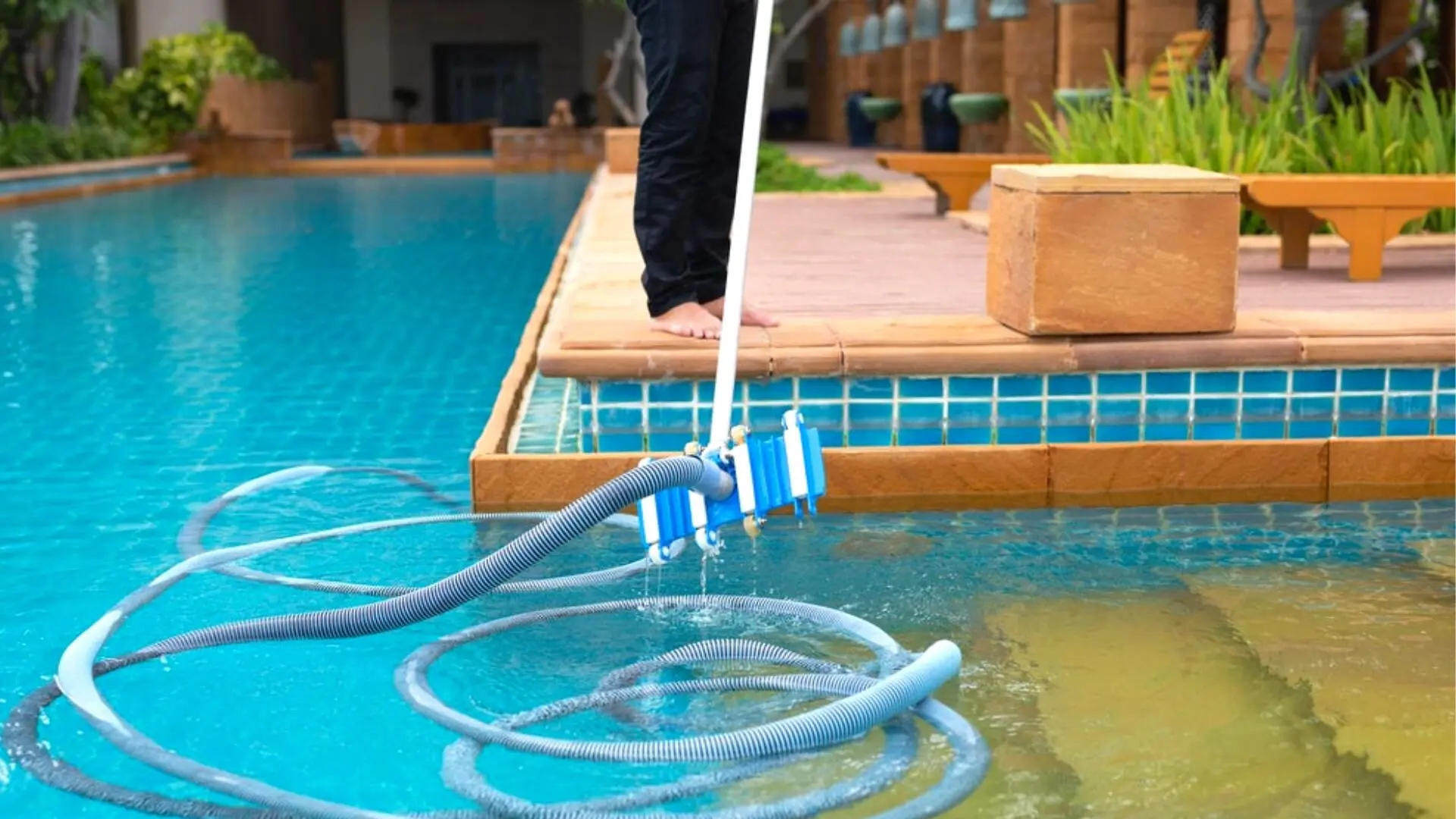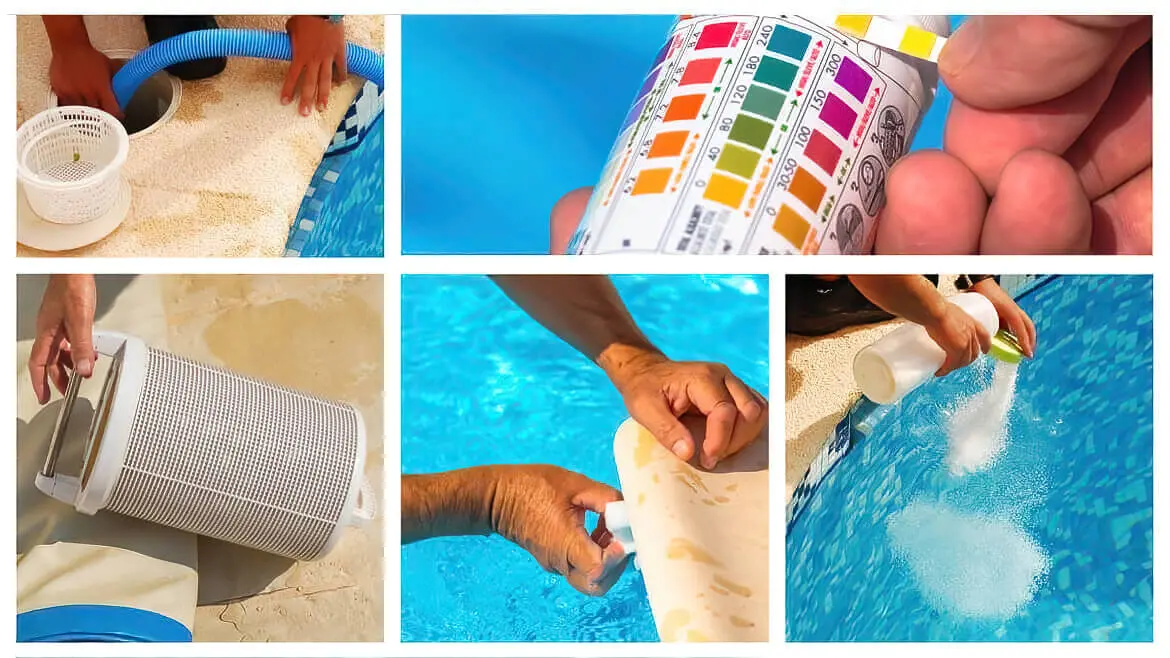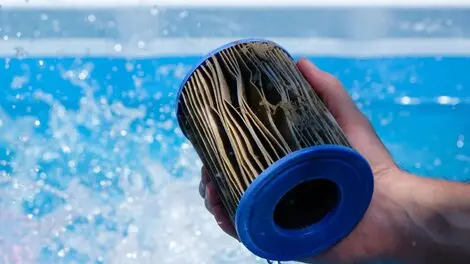Were you planning a pool party with friends this summer, only to cancel it at the last minute because you couldn’t get rid of the hideous green water?
Well...sorry about that! We understand nothing disappoints a pool owner more than a green pool and a cancelled party. But what’s the fun of swimming in water that looks like it hasn’t been cleaned in ages?
So, the question arises: what causes perfectly blue water to go green? In this guide, we’ve got the answers to why pool water turns green. To further help you, we’ve added some quick tips on regular pool maintenance and how to fix a green pool!

What Makes Pool Water Turn Green?
There are several reasons why the pool turns green. While algae formation is the most obvious answer, other elements can alter the colour.
1. Rain
Rain disrupts the swimming pool’s chemistry, which is otherwise carefully balanced. As a result, the pH levels are altered, and the chlorine and mineral content in the pool is diluted.
A rainstorm brings debris, leaves and dirt, all deposited in the pool. This decomposes, leading to the formation of phosphates in the water.
In addition, thunderstorms and lightning flashes contain nitrogen washed into the pool by rain. This nitrogen provides excellent fodder to the algae and sustains its growth.
Once algae spores find a foothold and the perfect climate to grow, they multiply quickly, and your pool can turn green overnight. Not only is algae growth awful-looking, but it also irritates your skin and causes numerous problems, such as eye and ear infections.
Keeping the pool covered during rain or thunderstorms is recommended to prevent water and other debris from entering and disrupting its chemical balance. Covering your pool also has many other benefits, including retaining heat.
2. Wrong Amount Of Chlorine
Is your pool water green? The most common reason the pool turns green is a disrupted chlorine balance. Adding chlorine to your pool keeps the growth of algae at bay and is an effective sanitiser for your pool, making the water safe and clean for swimming. It acts as a disinfectant and also eliminates materials such as chloramines. Thus, an imbalance of the chlorine level in the water leads to a spurt in algae growth.
An excessive amount of chlorine can also lead to discolouration of the pool. Often, people make the mistake of resorting to over-chlorination or a chemical shock to restore the chlorine balance. However, if not done right, this can oxidise the metal in your pool, causing the pool water to turn luminescent green. And you would not want to swim in your pool after this.
3. Pollen Buildup
Another reason your pool water might go green is the presence of pollen in it. The wind carries pollen from nearby trees and flower pots to the pool. The pool filter cannot eliminate this pollen, and its accumulation over time makes it turn green.
Even though it might give your pool a murky, green look and is often mistaken for algae, pollen has no harmful effects on the body. That said, it can clog the filter. Besides, pollen blooms worsen during spring, especially when you should take good care of the pool to avoid pollen build-up.
Before doing that, remember to differentiate between algae and pollen and treat it accordingly. Algae are slimy and stick to the pool’s walls, whereas pollen floats on the surface.
4. Metals
Heavy metals in the pool water can lead to staining. For example, copper is the most common metal in water and algaecides you use for pool cleaning. Thus, copper oxidises in water because of chlorine and acquires a light green hue.
Besides copper, several other metals like silver, iron and manganese are in the pool water. They are usually involved in the production of pipes and pool parts. However, not all of them turn green when oxidised.
It becomes challenging to differentiate between an algae invasion and the oxidation of copper in the pool water. We recommend determining the level of chemicals in the pool using metal test strips.
5. Malfunctioning Filter
A filter system that is not well-maintained can fail to collect debris or prevent algae build-up.
An ineffective filter will let the pool water stagnate, turning green. It is important to remember that the filtration system does most of the pool cleaning; without it, your pool water will be the hub of algae growth, mould, dirt and bacteria.
If you notice an excessive accumulation of dust particles or algae formation in the pool, try cleaning the filters and replacing them if needed.
6. Weather Conditions
Algae seek warm, humid temperatures for growth. As a result, hot weather and warmer months are a time for them to thrive. Using more potent pool chemicals like algaecides is essential to eliminate algae build-up.
Besides, clean the filters often during summer to remove algae and bacteria efficiently.
How To Fix A Green Pool?
Getting rid of a murky, green pool is not as difficult as it seems. All you have to do is follow a few essential steps, and you’ll have a thriving and sightly blue water back in no time.
You don’t want to have the hassle of cleaning a green pool regularly. Routine maintenance does not allow algae or bacteria to multiply, and the pool is ready with clear blue water whenever you want to swim.

Step 1: Test The Pool Water
A chemical kit can test the pH and chlorine levels in the pool. This helps determine the extent to which the pool water needs to be treated. All you need is a water sample and to follow the test kit instructions. If chlorine levels are acutely low, you must ‘shock’ the pool. The ideal pH level is 7.4. Ensure you are adding the appropriate dosage of chlorine for this,
If the pool turns green due to the oxidation of copper in the water, then a test kit can detect that.
Step 2: Clean The Filter
Before doing any treatment, clean the filter and remove debris, leaves, sticks or any other material that might be blocking it. If your filter is clogged, its efficiency is reduced; in that case, even a chemical treatment cannot combat algae growth. Your filter should be unclogged and functional.
Step 3: Brush The Pool Sides
Use algae or a regular pool brush to clean the pool’s edges. Algae clinging to the pool’s walls and sides must be meticulously removed. Scrub the sides, the pool floor and the walls. After this step, your pool will be ready for chlorine infiltration.
Step 4: Shock The Pool
The fourth and most crucial step in cleaning a pool is treating it with chlorine. In the process of “pool shock,” a high level of chlorine, which is tough enough to kill algae and bacteria, is introduced into the water. Algaecide is also used in the treatment of pool water.
Depending on the algae build-up, you can shock the pool more than once. Once that is done, let the water rest for a day and run the filter until it becomes crystal clear.
Step 5: Re-test The Chemical Levels
Use a swimming pool kit to test the water for chlorine, pH, and alkalinity. If everything is well balanced, the pool is ready for use.
How To Maintain The Pool?

Regular maintenance is the best way to avoid green pools, which is not much hassle. Remember a few crucial points, and you’ll be ready to go.
Tip 1: Wipe and Scrub The Pool Regularly
Wipe the tiles of the pool weekly and scrub the sides to prevent the build-up of algae. Skimmer baskets that absorb dirt and debris are located on the sides and require routine emptying.
Tip 2: Clean The Pool Filters
Sand filters must be cleaned fortnightly, cartridge filters are cleaned every month, and DE filters must be cleaned every five weeks. Regular maintenance of the filters will enhance their longevity and save you from expensive filter replacements.
Tip 3: Test The Pool’s Balance
You should check the pool’s chemical balance, chlorine concentration and pH level at least once weekly. It is essential to check your chlorine levels frequently because letting chlorine levels drop can cause a pool algae outbreak, as algae can proliferate.
Crystal Clear Results - How To Clear Up A Green Pool
With that, we come to the end of our guide. We hope getting clear blue water for your swimming pool will now be an easy task.
Neglecting pool maintenance is one of the most common mistakes owners make. Long story short, it is essential to eliminate algae and calcium build-up, prevent oxidation of chemicals and occasionally remove all grime and dust. After all, why should murky green water hinder your summer escapades? One thing to note is that the cloudiness of your pool will determine the amount of dead algae present.
Need assistance with your pool in Sydney? Contact our experts at The Pool Co. We can offer a wide range of solutions for your green pool water, including pool chemicals and automatic pool cleaners.
Till next time, enjoy the pool party!



